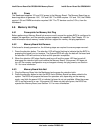
Intel® Server Board Set SE8500HW4 Server Management
Revision 1.0
Intel order number D22893-001
31
5.1.3 System Event Log (SEL)
The BMC allocates 65,536 bytes of non-volatile space for storing system events. Each event
record is padded with an additional four bytes of timestamp, resulting in 20 bytes of storage
space per record. A total of 3,276 SEL records can be stored in the system. When an attempt is
made to add a SEL record after 3,276 records, the BMC fails the request, an out of space
completion code is returned and the new event is not added to the SEL. The SEL can be
cleared in the system BIOS setup, or by using the SEL viewer utility or ISM application.
5.1.4 Rolling BIOS
The Intel
®
Server Board Set SE8500HW4 Mainboard provides two firmware hubs that can
contain two independent BIOS versions. This allows BIOS updates without a system reboot as
well as failover to a good BIOS image in the event of BIOS corruption. BMC support for this
feature includes the following:
Persistent storage of the currently selected the BIOS image (firmware hub) and the
validity of each image, on the IMM
OEM command support for the BIOS to query/change the currently selected the BIOS
image (firmware hub)
Physical control of the currently selected the BIOS image (firmware hub)
5.1.5 First Boot with a New IMM
Since the IMM is shared among several Intel server products, a new IMM may not be initially
programmed with the Intel
®
Server Board Set SE8500HW4 SDRs and BMC code. After
installing a new IMM, the user is required to load the Intel
®
Server Board Set SE8500HW4-
specific BMC firmware, SDRs and the BIOS during the first system boot.
The IMM module contains a persistent flag indicating the firmware hub that contains the primary
the BIOS image. During a BIOS update, the new BIOS image overwrites the inactive
(secondary) firmware hub. The IMM flag is updated to reference the inactive firmware hub as
the primary BIOS image and, after a reboot, the updated BIOS image will load.
A new IMM is programmed to boot using the BIOS image on firmware hub 0. For this reason,
users should always update BMC, SDRs and the BIOS when first installing a module. See
Table 10 for an example of rolling BIOS behavior with a new IMM.
Table 10. Example Rolling BIOS Behavior with a New IMM
Events Newest BIOS
available from
support.intel.com
Firmware Hub 0 Firmware Hub 1
Server received BIOS P02 BIOS P01 BIOS P01
New IMM installed BIOS P02
BIOS P01 (primary)
BIOS P01 (secondary)
BMC, SDRs, and BIOS
updated due to new IMM
installation
BIOS P02 BIOS P01 (secondary)
BIOS P02 (primary)
Server is in use for
months …
BIOS P03 BIOS P01 (secondary)
BIOS P02 (primary)
BIOS updated because a BIOS P03
BIOS P03 (primary)
BIOS P02 (secondary)


















